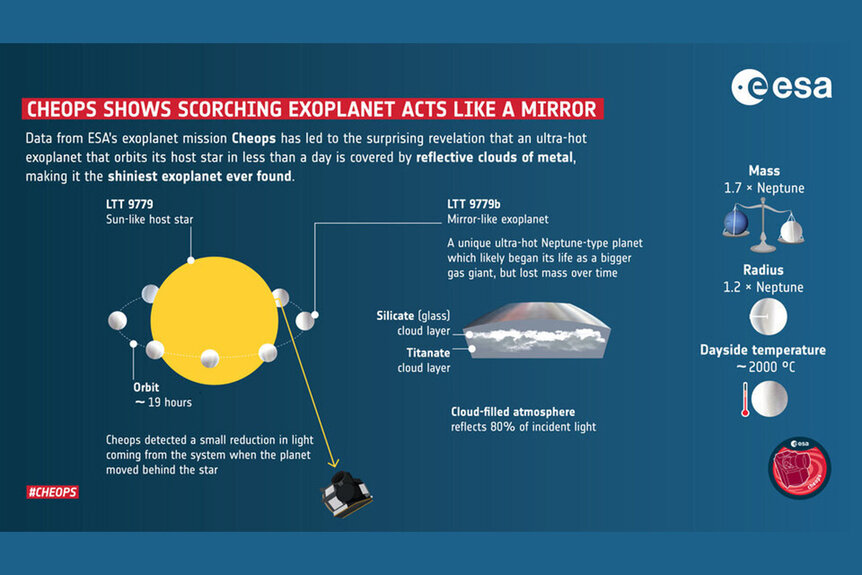Create a free profile to get unlimited access to exclusive videos, sweepstakes, and more!
This Weird Planet Is the Shiniest We’ve Ever Seen, Thanks to Metal Clouds
It's basically covered in a mirror glaze.
The time between the first powered flight and Apollo 11 landing on the Moon was less than a human lifetime. Since then, we’ve put remote controlled cars on Mars and shot spacecraft into interstellar space. As we prepare to return to the Moon and eventually to Mars, one can’t help but imagine where we’ll be a century from now. If the creators of SYFY's The Ark (streaming now on Peacock!) are correct, we’ll be setting off for a new world around the star next door, Proxima centauri.
Proxima centauri b might technically be habitable, but it’s so different from the Earth that it would never really feel like home. In fact, that’s likely to be true of most every place we find and visit. With that in mind, if we have to live somewhere weird, we might as well live somewhere glamorously weird. Our suggestion: the exoplanet LTT9779 b, the most reflective world we’ve ever found.
The Shiniest Objects in the Night Sky
How bright something appears to us is a function of two properties: the actual amount of light being emitted or reflected, and its distance. Assuming there isn’t anything between you and an object, there’s a clear relationship between distance, luminosity, and apparent brightness. For those reasons, the Sun always wins the local contest, and the Moon is a close second. It isn’t actually very bright, but it’s pretty big and very close, astronomically speaking.
RELATED: The JWST Bagged Its First Exoplanet, A Sweltering Earth-Sized World
Putting aside the Sun and the Moon, Venus is the brightest cosmic object in the sky. It appears during certain parts of the year, low on the horizon. It outshines everything else in the sky because it’s relatively close and because its atmosphere is highly reflective, bouncing about 75% of the sunlight that hits it back into space. For comparison, Earth reflects about 30% and the Moon reflects only 3% to 12% of the sunlight that strikes it.
Now scientists have identified a world with record-breaking reflectivity, bouncing 80% of its parent star’s light back into space. The planet LTT9779 b is about 262 lightyears from here, basically in the next town over cosmically speaking, and it’s highly reflective thanks to its strange atmospheric composition.
Researchers studied the planet using the European Space Agency’s (ESA) Characterizing Exoplanet Satellite (CHEOPS). The data revealed an atmosphere filled with silicates (think glass or sand) and metals like titanium. Moreover, the temperatures on LTT9779 b are estimated at 2,000 degrees Celsius, plenty hot to melt titanium.
RELATED: 5,000th Exoplanet Found!
LTT9779 b orbits incredibly close to its parent star, completing an orbit every 19 hours. At those distances, temperatures are high enough that astronomers predict clouds made of liquid titanium, raining scorching metal onto the planet’s surface. In the meantime, they bounce most of the starlight back into space more efficiently than any other world we’ve found. In fact, the planet’s metal clouds may be the only reason it exists at all.
At about the same size as Neptune and orbiting as closely as it is, astronomer predict its atmosphere should have evaporated or been blown away by the stellar wind. According to some models, a world like LTT9779 b shouldn’t exist. It’s possible that the highly reflective clouds act as a giant mirror, bouncing starlight back into space, keeping the atmosphere intact, and sending a signal to astronomers hundreds of lightyears away.
On second thought, Proxima centauri b is probably preferable to the liquid titanium rain planet. Catch The Ark, streaming now on Peacock!




































